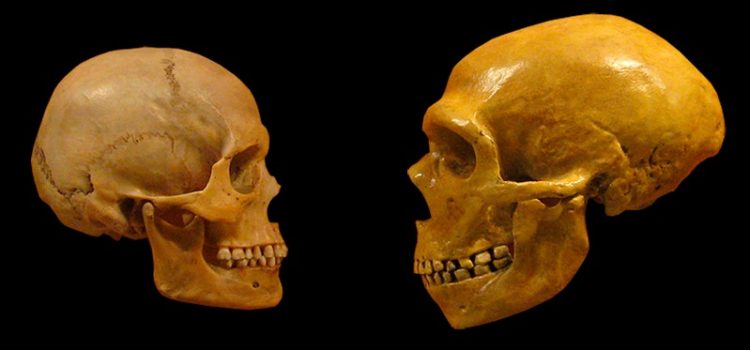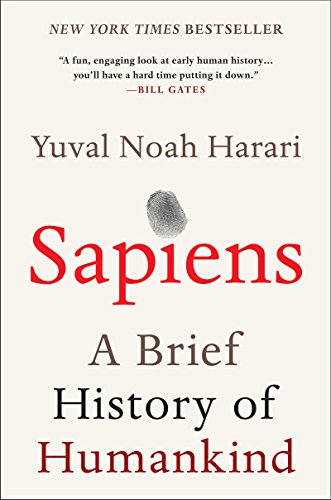

This article is an excerpt from the Shortform summary of "Sapiens: A Brief History of Humankind" by Yuval Noah Harari. Shortform has the world's best summaries of books you should be reading.
Like this article? Sign up for a free trial here .
Is there Neanderthal DNA in modern humans? How much? How did it get there?
Some people have up to 4% Neanderthal DNA. This is because early Homo sapiens, our species, interbred with Neanderthals, a different human species.
Learn the difference between Neanderthals and early Homo sapiens and how researchers made the surprising discovery that there’s Neanderthal DNA in some modern humans.
People with Neanderthal DNA
Before we explore Neanderthal DNA in modern humans, let’s look at the big picture.
We tend to think of the evolution of humans as a linear progression from Homo erectus to Neanderthals to Homo sapiens, but at least six human species were alive when our own lived on earth, and others may yet be discovered. The known human species included Homo soloensis, Homo floresiensis, Homo denisova, Homo rudolfensis, and Homo ergaster. The three that will play the biggest roles in this book are:
Homo neanderthalensis (“Man from the Neander Valley”): Also known as Neanderthals, these humans lived in western Asia and Europe. They were more muscular than we were and they had bigger brains than we did (or do today). We’ll see why the Neanderthal species died out, even though Neanderthals were superior to Sapiens in many ways.
Homo sapiens (“Wise Man”): Us. Our species of man also evolved in East Africa.
Why Didn’t Neanderthals Survive Into the Modern Age?
Sapiens came to dominate the animal kingdom. Neanderthals died out. Why?
Early theories suggested that either A) Sapiens bred with other humans, merging the various human species, or that B) Sapiens were too genetically different from other species to procreate with them, meaning that all humans currently alive are pure sapiens.
What’s the Highest Percentage of Neanderthal DNA in Modern Humans?
Both of these theories are flawed. For years, Theory B had more archeological evidence to support it. But then the results of a 2010 project to map the Neanderthal genome showed that 1-4% of Middle Eastern and European DNA is Neanderthal DNA. A few months later, results from an analysis of the DNA of newly-discovered Denisova showed that 6% of Melanesian and Aboriginal Australian DNA is Denisovan DNA. These results are still new and need to be confirmed. Even if they are confirmed, they don’t suggest a “merger” of genes as in Theory A—such small percentages hardly suggest that two species of humans “merged.” What they do suggest is that a small amount of interbreeding happened, enough that we still harbor the DNA of another species, but it was rare.
The current evidence leaves us with two options to explain the disappearance of other humans, such as Neanderthals.
- Option #1: Due to their superior tools and collaboration skills, Sapiens were better hunters and gatherers, and as they migrated to new geographic areas, they out-competed the human species that originally called that area home. Neanderthals, who were less resourceful, had trouble feeding themselves, and they slowly died out.
- Option #2: Genocide. Modern Sapiens have fought wars with others because of their differences in skin color, culture, and religious beliefs. Would Sapiens be any more tolerant of humans of an entirely different species? Or maybe it was their familiarity that motivated Sapiens to kill their fellow humans. Perhaps other humans, particularly the Neanderthals, were too similar to Sapiens. Neanderthals were a threat to a species that wanted to dominate the animal kingdom.
Neanderthals became extinct, but their DNA survives today with Neanderthal DNA in modern humans.
———End of Preview———

Like what you just read? Read the rest of the world's best summary of "Sapiens" at Shortform . Learn the book's critical concepts in 20 minutes or less .
Here's what you'll find in our full Sapiens summary :
- How Sapiens outlived and outlasted the 8+ other human-like species on Earth
- The 3 critical revolutions in human existence that led to our domination of the planet
- How much of what powers our world today is really just a shared mass delusion
- What the future of humanity might look like






